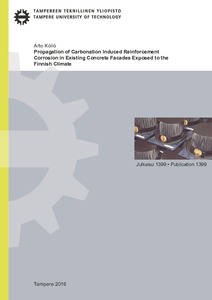Propagation of Carbonation Induced Reinforcement Corrosion in Existing Concrete Facades Exposed to the Finnish Climate
Köliö, Arto (2016)
Köliö, Arto
Tampere University of Technology
2016
Tieto- ja sähkötekniikan tiedekunta - Faculty of Computing and Electrical Engineering
This publication is copyrighted. You may download, display and print it for Your own personal use. Commercial use is prohibited.
Julkaisun pysyvä osoite on
https://urn.fi/URN:ISBN:978-952-15-3800-1
https://urn.fi/URN:ISBN:978-952-15-3800-1
Tiivistelmä
Reinforced concrete is present in the major part of the Finnish built environment. A vast number of concrete buildings utilizing newly developed prefabrication techniques were built from 1960 to 1979. Since then, the durability properties of the concrete building stock from this era have been found to be poor in regard to freeze-thaw action and the corrosion of the reinforcement. This building stock has now reached an age when many of the building components are due to be renovated. Because of the huge volume of this building stock, its renovation is also challenging in terms of resources.
In terms of the corrosion of the reinforcement, the service life of these concrete structures is composed of two phases. The initiation phase withholds the onset of favourable conditions for corrosion, while the second phase, the propagation phase, includes the corrosion process of the steel itself. The former is traditionally used as a measure of a building’s service life, even though no damage has yet occurred at this stage. However, the service life of a building may be extended by utilising the propagation phase, which would aid in prioritising renovation projects for existing concrete structures once the initiation phase has already passed.
This thesis discusses the propagation phase (active corrosion) as part of the service life of concrete facade panels in the Nordic climate. The objective of the research is to add to our knowledge of the corrosion propagation phase in such structures under actual long-term weather exposure, and to generate data for modelling the process. The study combined a statistical analysis of a large database of condition investigation data, a more in-depth analysis of twelve building case studies and data from field measurements of reinforcement corrosion. Using regression analysis, long-term, time series weather data from the geographical locations of the buildings were compared with the actual corrosion rates. The result is a model to describe corrosion propagation in concrete facades and balcony panels in relation to the prevailing weather. The concrete facades’ orientation, obstruction and shelter from vegetation were found to have a decisive impact on the rate of active corrosion. The analysis showed that propagation phase can be used to considerably extend the service life of the concrete, although for buildings in more exposed locations, this may only be a few years. This time period may, however, provide the necessary latitude for the renovation budget.
In terms of the corrosion of the reinforcement, the service life of these concrete structures is composed of two phases. The initiation phase withholds the onset of favourable conditions for corrosion, while the second phase, the propagation phase, includes the corrosion process of the steel itself. The former is traditionally used as a measure of a building’s service life, even though no damage has yet occurred at this stage. However, the service life of a building may be extended by utilising the propagation phase, which would aid in prioritising renovation projects for existing concrete structures once the initiation phase has already passed.
This thesis discusses the propagation phase (active corrosion) as part of the service life of concrete facade panels in the Nordic climate. The objective of the research is to add to our knowledge of the corrosion propagation phase in such structures under actual long-term weather exposure, and to generate data for modelling the process. The study combined a statistical analysis of a large database of condition investigation data, a more in-depth analysis of twelve building case studies and data from field measurements of reinforcement corrosion. Using regression analysis, long-term, time series weather data from the geographical locations of the buildings were compared with the actual corrosion rates. The result is a model to describe corrosion propagation in concrete facades and balcony panels in relation to the prevailing weather. The concrete facades’ orientation, obstruction and shelter from vegetation were found to have a decisive impact on the rate of active corrosion. The analysis showed that propagation phase can be used to considerably extend the service life of the concrete, although for buildings in more exposed locations, this may only be a few years. This time period may, however, provide the necessary latitude for the renovation budget.
Kokoelmat
- Väitöskirjat [4773]
